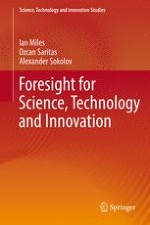2016 | OriginalPaper | Chapter
5. Intelligence: Environmental and Horizon Scanning
Authors : Ian Miles, Ozcan Saritas, Alexander Sokolov
Published in: Foresight for Science, Technology and Innovation
Publisher: Springer International Publishing
Activate our intelligent search to find suitable subject content or patents.
Select sections of text to find matching patents with Artificial Intelligence. powered by
Select sections of text to find additional relevant content using AI-assisted search. powered by
